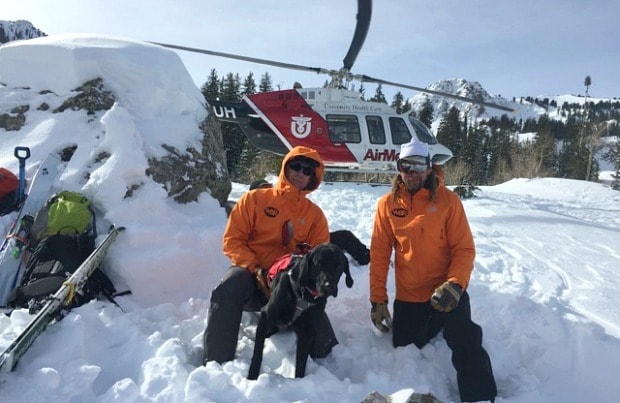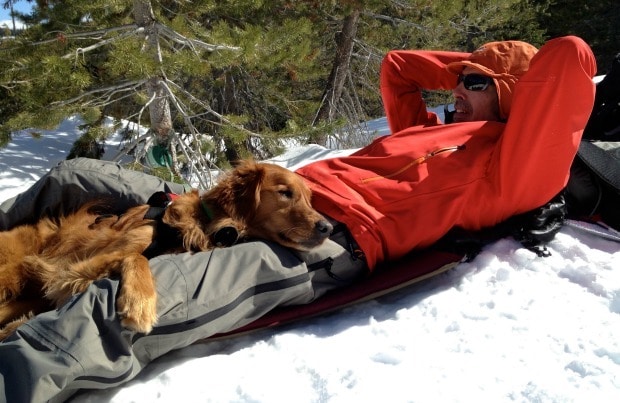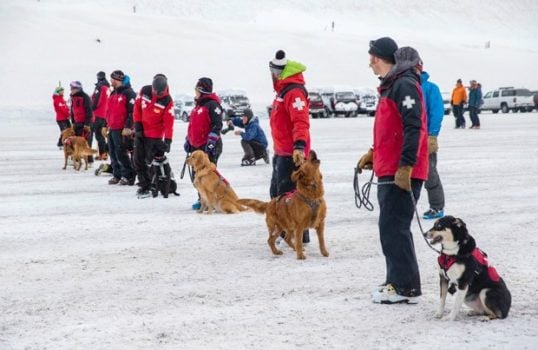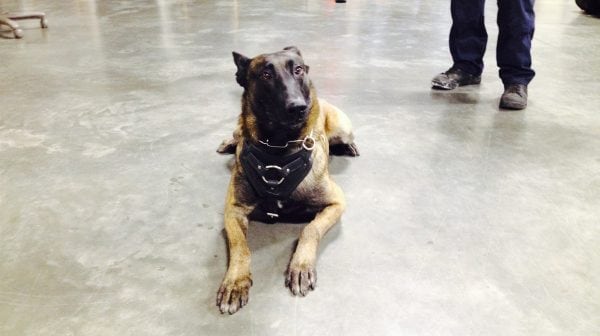By day, Chipper is like any other dog. The eight-year-old Golden Retriever likes to go for hikes and bark at the dogs that pass her house. She even tolerates the family cat.
But when owner Gordon Durand gets a text from the California Office of Emergency Services, Chipper trades her dog chew toy for a bright red reflective vest. Instead of cuddling with Kitty, she’s on a mission to save lives.
Chipper and Durand are one of 149 certified dog teams registered with the California Rescue Dog Association, or CARDA.
CARDA members work throughout the state, rescuing hikers and skiers who get trapped during avalanches. The teams also help with missing people searches, crime scene investigations, and rescue work after natural disasters. CARDA teams have worked on high profile missions around the world, including the 1995 Oklahoma City bombing, and earthquakes in Mexico City.

For CARDA members, it’s a labor of love, duty, and adventure. The volunteers pay for their equipment, mileage, and pet care.
“We jokingly refer to ourselves as the $20,000 dog club,” says Durand. “We’re all pretty heavily invested in this.”
So are the dogs.
Durand started working with Chipper when she was just eight weeks old. The pup enlisted in formal training as soon as her shots cleared.
For Chipper and her avalanche rescue dog cohorts, the goal is to learn there will be a prize if they follow their noses. When Chipper was a puppy, Durand hid her favorite toys around the house. When she retrieved them, he rewarded her with her favorite game in the world: tug of war. It’s a lesson she now applies to searches.
“After countless hours of repetition, my dog thinks people are hiding in the woods waiting to play tug of war with her,” Durand says.
Following their noses is only a fraction of the training required to earn the title of avalanche rescue dog. The dogs have to be strong swimmers and nimble runners, and must learn to adapt to the loud noises of helicopters and snowmobiles. Because searches can take up to eight hours and involve multiple rescue teams, the dogs must have grit and endurance, and be well socialized.

The ability to work off leash is also important. Handlers must be able to control their dogs from up to 100 yards away. CARDA members typically train for two years before participating in searches.
“We go for a functional level of obedience,” says Durand.
The dogs love the work, handlers say. It’s a social event. They get to run with other dogs. They get to hunt, dig, and bark wildly when they make a find.
When CARDA member Lynn Macaulay breaks out her yellow Lab Ophir’s search vest, the tail starts wagging and he makes a beeline for the front door.
“It doesn’t matter what the weather is. As soon as he knows he’s going on a rescue, he starts bouncing off the walls,” she says.
The survival window after being caught in an avalanche is only about 20 minutes. The dogs’ ability to track down a skier’s scent makes them an integral part of the search and rescue team, says Sergeant James Blanton of the Unified Police Department of Greater Salt Lake.
“Time is of the essence,” he says. “The dogs are phenomenal. They can find a victim a lot quicker than any individual.”
Every search is treated with a strong sense of urgency. But all too often, the mission is a recovery rather than a rescue.
To increase the odds of survival, avalanche rescue dogs are often positioned at ski resorts. The Wasatch Backcountry Rescue group, or WBR, is composed of more than 40 professional dog rescue teams working at nine ski resorts throughout northern Utah. About a third of their calls are for avalanche rescues.
On the powder, handlers have to be incredibly in tune with their dogs, says Tracy Christensen, president of WBR. For 10 years he worked with his dog Mick, a yellow lab. His current pup, Jagger (guess who Christensen’s favorite band is), is in training.
“The bond I had with Mick was so special, I could tell by the way he wagged his tail and by the way he put his paws on the snow whether he was just investigating, had found an article of clothing, or was digging up a live find,” Christensen says.
The relationship stretches off the ice too.

“It’s hard to describe,” says Chipper’s owner Durand, who worked with his previous pup Hana for nearly a decade before she passed away. “The two of you spend thousands of hours training and working together in horrible conditions. You develop a working relationship that is really rewarding, but it’s also so hard when the dogs pass away.”
Handler Macaulay says she usually wakes up to find Ophir wedged blissfully belly-up in between her and her husband. At Christensen’s home, Jagger is by his side from breakfast to dinner.
When they’re not on the clock, the dogs’ job is to be the family pet. But not just any family pet.
“Now this isn’t the dog sitting next to me on the couch eating Cheetos,” Christensen says. “They are athletes and always ready for work the next day.”
Images courtesy Tracy Christensen and Gordon Durand

Helen Anne Travis is a freelance writer based in Tampa, FL. She also writes for CNN, The Guardian and The Globe and Mail.
Share:









